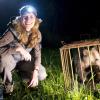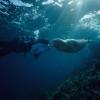By their sheer size and original shapes, baobabs are among the most remarkable trees on the planet. Relatively unknown in Madagascar, these giants are currently threatened by deforestation. To study them, in the heart of their forests, Cyrille Cornu and Wilfried Ramahafaly travel by pirogue, exploring 400 km of wild and isolated coastline in the south-west of Madagascar. The film chronicles the expedition. It reveals discoveries, meetings, scientific results of the two explorers, baobabs and landscapes that had mostly never been filmed or even photographed!
Films 2015
First Prize – “Town of Sondrio” Award 2015
Baobabs entre Terre et Mer
Stelvio National Park Award 2015
Sulle tracce dei ghiacciai: missione in Alaska
After the successful expedition to Karakorum and to Caucasus, photographer Fabiano Ventura and his team of experts continue their mission to study the effects of climate change on the world’s largest glaciers. Their next expedition will take them to Alaska. Thanks to the cold weather and the frequent precipitations, glaciers are found in Alaska at low altitudes; they pass through the long valleys and merge just before they arrive at the sea. Their particular characteristics make Alaska’s glaciers very interesting from a scientific point of view. Once again, in this documentary, photographic evidence gathered by explorers of the late nineteenth century and early twentieth century is compared with the same shots taken by Fabiano Ventura. These are then scientifically analyzed to determine the “health” of some of the largest glaciers in the world.
“Lombardy Region” Award 2015
Bears were wiped out in many parts of Europe, now they are slowly starting to spread again. The perception of brown bears still ranges from cuddly toy to monster – so not everybody is happy about a potential bear in their backyard. The film team witnesses, when Rumanian “garbage bears” are relocated back into the woods. They take a look at the Alps, where people protect their garbage against roaming bears – because the bears are already on the rise. But can we still live with them today?
Special Mention
The film portays a local schoolboy educating a friend by telling her a story about the benefits of living alongside elephants. He shows her around his community, which borders Ruaha National Park, in Tanzania and is home to the highest population of wild elephants left in Tanzania. The film focuses on the natural beauty and biodiversity of Ruaha, as well as touching on the complex political and economic issues surrounding habitat degradation, elephant population decline and poaching in the region.
Student Jury Award 2015
Forget that dark swamp picture: the Everglades in fact is a crystal clear shallow river flowing slowly towards the sea. This is an intimate portrait of this strange but troubled watery wilderness through the stories of the animals which call it home. The film has been shot for over two years and the filmmakers captured some never before filmed animal behaviors in this unique National Park.
“Achille Berbenni” Award assigned by the Audience Jury 2015
In the Rwenzori mountains, the wide source area of the Nile contains a spectacular feature. One snow-covered peak reaches 5,000 metres above sea level. Underneath its glacier, a fairy-tale forest expands, covered with Giant Lobelia and Aster plants. In this damp and cold world, the stunningly beautiful Lobelia Scarlet-tufted Malachite Sunbird lives its life. The males defend their plants, until the female birds arrive from warmer climes for the mating season. Forests at lower altitudes provide a paradise for reptiles like the insect-hunting chameleons unique to these mountains. The source furthest away from the Nile delta lies in Rwanda’s Nyungwe National Park. Thirteen species of primates live there, most notably the truly acrobatic Angola Colobus.
This enigmatic forest, the Mata Atlantica or Atlantic Rainforest, once stretched along the coast for thousands of kilometres. Now there is only 7% left. Yet it is still huge – stretching for thousands of kilometres along the coast and reaching inland up to six hundred kilometres. In the centuries since Europeans landed on Brasil’s shores the Mata Atlantica forest has continued to be cleared. But what remains is still a place of immense beauty and variety. An enigmatic and little known forest, home to South America’s largest monkey, swifts that fly through waterfalls and birds that take 10 years to learn the right dance moves.
The “Place in Between”, “The Big Empty”, “Flyover Country” - it goes by many bleak names, but North America’s iconic sagebrush steppe is far more than the forgotten backdrop of a Hollywood western - it is the planet’s only home for a deceptively subtle ecosystem: a vast wilderness spanning 250,000 square miles which, at second glance, is brimming with hardy life. But despite its size, this veritable sea of sagebrush is a fragmented landscape with a tenuous future. As we begin to leave our mark here, wringing profit from the land, the marks of other lives more ancient - the cascading songs of sage thrashers, the otherworldly booming of strutting grouse, or the widely-spaced tracks of a Pronghorn’s sprint - are at risk of fading away.
The film is a coming-of-age story as four sister tigers battle each other for dominance over their homeland. Once the girls grow older and stronger, instinct kicks in and they separate, competing with each other to take control of their mother’s territory - Telia Lake. Their bond is broken and the family is torn apart. To survive independently, each sister must make one large kill every week. However, alone, each struggles. Desperate and starving, the four sisters make a startling choice. They join forces to hunt as a pack and take on dangerous prey.
Highlighting the breeding season on California’s coastline for Northern Elephant Seals, this short documentary explores these incredible marine mammals.
Iraq’s Mesopotamia Marshes had been a vital life force for centuries until Saddam Hussein destroyed them with a devastating military maneuver. Azzam Alwash has taken on the challenge of restoring the marshes to their original splendor. Recently Azzam’s efforts were rewarded when the Iraq government declared the marshes the country's first National Park.
Lune
Since the dawn of time, the Moon plays a fundamental role in biological life: it acts like the pendulum of the terrestrial clock, dictating its rhythm to everything alive. As a universal symbol and a source of fascination, the Moon is present in every civilization, through myths, legends and dreams. The film will take us on a scientific odyssey revisiting the incredibly subtle clockwork linking the Moon to the Earth. In a perfect balance with the sun, Moon's attraction enabled life to bloom on our blue planet. It will also take viewers on a journey across the ages, cultures and religions revealing the fascination and powerful source of inspiration provided by this satellite.
Kamenjak Nature Reserve is the southernmost tip of the Istrian peninsula. This place has been in the local and international news for some years due to an unexpected, surprising return. The Mediterranean monk seal, one of the rarest species in the world, has become a regular presence in these parts. Known as a shy and wary creature, there are now so few surviving monk seals that the species is considered to be in danger of extinction. Yet for some years man and seal have been peacefully coexisting in this corner of the Mediterranean, in part thanks to the work of a number of passionate volunteers: a story worth telling.
Red rocks and kangaroos at sunset – this is Australia as we know it. The most concealed area remains perhaps the most mysterious on the fifth continent: the tropical rainforest in the north east of the country is home to kangaroos who climb in the trees. In the swamps lurk “Salties”, the largest crocodiles on earth, waiting for unsuspecting prey. Deep in the jungle live curious birds of paradise and the cassowary – a huge bird who appears to be from prehistoric times. You’d do well to avoid his strong beak and clawed dinosaur feet, especially when the cassowary has offspring in tow – although the babies look more like wild boar piglets than chicks while searching for food on the forest floor … Down Under is a continent full of natural wonders!
Vo vetre kopýt
Muranska Planina is a special place for a unique breeding station for Muransky Norik horses. It is in the middle of the wild Slovak nature which makes horses feel free as wild animals. Nature is their original habitat. What about people who take care of them? Is wilderness comfortable enough? Many swap luxury of civilization for hard life in the wild and say that this way of life made their dreams come true.
Vuoi far parte della Giuria del Pubblico di Sondrio Festival?
Stiamo selezionando la Giuria del Pubblico di Sondrio Festival 2025.
Se sei interessato a farne parte invia la tua candidatura via e-mail a
info@sondriofestival.it.






